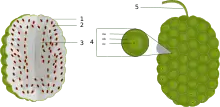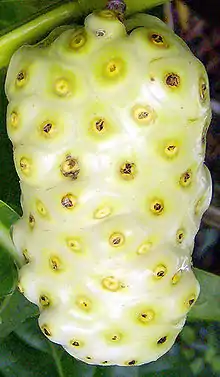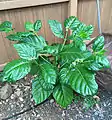| Morinda citrifolia | |
|---|---|
.jpg.webp) | |
| Leaves and noni fruit | |
| Scientific classification | |
| Kingdom: | Plantae |
| Clade: | Tracheophytes |
| Clade: | Angiosperms |
| Clade: | Eudicots |
| Clade: | Asterids |
| Order: | Gentianales |
| Family: | Rubiaceae |
| Genus: | Morinda |
| Species: | M. citrifolia |
| Binomial name | |
| Morinda citrifolia | |
Morinda citrifolia is a fruit-bearing tree in the coffee family, Rubiaceae, native to Southeast Asia and Australasia, and was spread across the Pacific by Polynesian sailors.[1] The species is now cultivated throughout the tropics and widely naturalized.[2] There are over 100 names for this fruit across different regions. Common English names include great morinda, Indian mulberry, noni, beach mulberry, vomit fruit, awl tree, and cheese fruit.[3]
The pungent odor of the fresh fruit has made it a famine food in most regions, but it remains a staple food among some cultures and is used in traditional medicine. In the consumer market, dietary supplements are sold in various formats, such as capsules and juices.

Growing habitats
Morinda citrifolia grows in shady forests and on open rocky or sandy shores.[4] It takes 18 months for the plant to mature, and yields 4 and 8 kg (8.8 and 17.6 lb) of fruit per month throughout the year. It is tolerant of saline soils, drought conditions, and secondary soils. It can be found in various environments including volcanic terrains, lava-strewn coasts, and clearings or limestone outcrops, as well as in coral atolls.[4] It can grow up to 9 m (30 ft) tall and has large, simple, dark green, shiny, and deeply veined leaves.
The plant bears flowers and fruits all year round. The fruit is a collective of multiple fleshy fruits that emit a pungent odor while ripening. It is commonly cited as "cheese fruit" or "vomit fruit". It is oval in shape and reaches 10–18 centimetres (3.9–7.1 in) in size. At first green, the fruit turns yellow, then almost white as it ripens. It contains many seeds.[4]
Morinda citrifolia is attractive to weaver ants, which make their nests by using the leaves of this tree.[4] These ants protect the plant from some plant-parasitic insects. The smell of the fruit also attracts fruit bats, which aid in dispersing the seeds. A type of fruit fly, Drosophila sechellia, feeds exclusively on these fruits.[5]
Uses

A variety of beverages (juice drinks), powders (from dried ripe or unripe fruits), cosmetic products (lotions, soaps), oil (from seeds), and leaf powders (for encapsulation or pills) have been introduced into the consumer market.[6]
Culinary
Indigenous peoples used the Noni fruit as emergency food during the famine.[6] Therefore, it is also called "starvation fruit". Despite its strong smell and bitter taste, the fruit was nevertheless eaten as a famine food,[7] and, in some Pacific Islands, even as a staple food, either raw or cooked.[8] Southeast Asians and Aboriginal Australians consume fresh fruit with salt or cook it with curry.[9] The seeds are edible when roasted. In Thai cuisine, the leaves known as bai-yo are used as a green vegetable and are the main ingredient of Kaeng bai-yo, cooked with coconut milk. The fruit luk-yo is added as a salad ingredient to some versions of Som tam.
Traditional medicine
Green fruit, leaves, and root or rhizomes might have been used in Polynesian cultures as a general tonic, in addition to its traditional place in Polynesian culture as a famine food.[6] Although Morinda is considered to have biological properties in traditional medicine, there is no confirmed evidence of clinical efficacy for any intended use.[10] In 2018, a Hawaiian manufacturer of noni food and skincare products was issued an FDA warning letter for marketing unapproved drugs and making false health claims in violation of the US Food, Drug, and Cosmetic Act.[11]
Dyes
Noni fruit has traditionally been used by Austronesian peoples mainly for producing dyes. It was carried into the Pacific Islands as canoe plants by Austronesian voyagers. Morinda bark produces a brownish-purplish dye that may be used for making batik. In Hawaii, yellowish dye is extracted from its roots to dye cloth.[12][13] Yolngu artists at Bula'Bula Arts in Ramingining, in central Arnhem Land in the Northern Territory of Australia, use the roots and bark of "djundom," as it is known to them, to dye the fibres of pandanus to create a wide variety of artifacts.[14]
The use of M. citrifolia as a fabric dye, and applying a mordant to the fabric before dyeing is necessary. This process can be labor-intensive if the goal is to achieve shades and hues with the morinda dye.[15]
Popular culture
The fruit is widely used in eating challenges in the British reality television program I'm a Celebrity...Get Me Out of Here! where it is referred to as "vomit fruit."[16]
Nutrients and phytochemicals
Morinda citrifolia fruit powder contains carbohydrates and dietary fibre in moderate amounts.[17] These macronutrients reside in the fruit pulp, as M. citrifolia juice has sparse nutrient content.[18] The main micronutrients of M. citrifolia pulp powder include vitamin C, niacin (vitamin B3), iron, and potassium.[17] Vitamin A, calcium, and sodium are present in moderate amounts. Compared to powdered pulp, only vitamin C is retained in the analysis of M. citrifolia juice.[18] The juice contains 34 mg of vitamin C per 100 g, which is 64% of the amount found in a raw navel orange (53 mg per 100 g of orange, or 89% of the Daily Value).[19] Sodium levels in M. citrifolia juice (about 3% of Dietary Reference Intake, DRI)[17] are high compared to an orange, while potassium content is moderate.[19]
Morinda citrifolia fruit contains several phytochemicals, including lignans, oligo- and polysaccharides, flavonoids, iridoids such as deacetylasperulosidic acid,[20] fatty acids, scopoletin, catechin, beta-sitosterol, damnacanthal, and alkaloids.[21]
Gallery
 M. citrifolia flower
M. citrifolia flower Young noni growing on Oahu, Hawaii.
Young noni growing on Oahu, Hawaii.
See also
References
- ↑ Pieroni, Andrea (2005). Prance, Ghillean; Nesbitt, Mark (eds.). The Cultural History of Plants. Routledge. p. 36. ISBN 0415927463.
- ↑ Nelson, SC (2006-04-01). "Species Profiles for Pacific Island Agroforestry: Morinda citrifolia (noni)". Traditional Tree Initiative.
- ↑ "Some worldwide names for Morinda citrifolia L." The Noni Website. University of Hawai‘i at Manoa, College of Tropical Agriculture and Human Resources. 2006. Retrieved 11 June 2023.
- 1 2 3 4 Nelson, Scot C (March 2001). "Noni cultivation in Hawaii" (PDF). The noni website, University of Hawai‘i at Manoa, College of Tropical Agriculture and Human Resources. Retrieved 12 November 2016.
- ↑ Jones, C.D. (1998). "The Genetic Basis of Drosophila sechellia's Resistance to a Host Plant Toxin". Genetics. 149 (4): 1899–1908. doi:10.1093/genetics/149.4.1899. PMC 1460277. PMID 9691045.
- 1 2 3 Nelson, Scot C (8 October 2003). "Morinda citrifolia L." (PDF). Permanent Agriculture Resources, University of Hawaii. Retrieved 12 November 2016.
- ↑ Krauss, BH (December 1993). Plants in Hawaiian Culture. Honolulu: University of Hawaii Press. p. 272. ISBN 978-0-8248-1225-6.
- ↑ Morton, Julia F. (1992). "The ocean-going noni, or Indian Mulberry (Morinda citrifolia, Rubiaceae) and some of its "colorful" relatives". Economic Botany. 46 (3): 241–56. doi:10.1007/BF02866623. S2CID 41054660.
- ↑ Cribb, A.B. & Cribb, J.W. (1975) Wild Food in Australia. Sydney: Collins.
- ↑ Potterat O, Hamburger M (2007). "Morinda citrifolia (Noni) fruit--phytochemistry, pharmacology, safety". Planta Medica. 73 (3): 191–9. doi:10.1055/s-2007-967115. PMID 17286240.
- ↑ Darla Bracy, Division Director (18 July 2018). "Warning letter: Hawaiian Organic Noni, LLC". Inspections, Compliance, Enforcement, and Criminal Investigations, US Food and Drug Administration. Retrieved 15 August 2018.
- ↑ Thompson, RH (1971). Naturally Occurring Anthraquinones. New York: Academic Press.
- ↑ Nelson, Scot C. (2006). "Pandanus tectorius (pandanus)". In Elevitch, Craig R. (ed.). Species Profiles for Pacific Island Agroforestry (PDF). Permanent Agriculture Resources (PAR).
- ↑ Allam, Lorena; Moore, Isabella. "'Bringing the sun in': the hardworking weavers of Bula'Bula dig colour from the red earth". The Guardian. Retrieved 26 August 2023.
- ↑ Khan Majlis, Brigitte (2007). "Deft Hands and Divine Patterns: An Introduction to Indonesian Textile Techniques". Art Institute of Chicago Museum Studies. The Art of Indonesian Textiles: The E. M. Bakwin Collection at the Art Institute of Chicago. 33 (2): 25. JSTOR 20205554.
- ↑ "What is vomit fruit, as seen on I'm A Celebrity?". Metro. 23 November 2019. Retrieved 11 November 2022.
- 1 2 3 Nelson, Scot C. (2006) "Nutritional Analysis of Hawaiian Noni (Noni Fruit Powder)" The Noni Website. Retrieved 15-06-2009.
- 1 2 Nelson, Scot C. (2006) "Nutritional Analysis of Hawaiian Noni (Pure Noni Fruit Juice)" The Noni Website. Retrieved 15-06-2009.
- 1 2 "Nutrition data for raw oranges, all commercial varieties, per 100 gram amount". Nutritiondata.com. Conde Nast for the USDA National Nutrient Database, Release SR-21. 2014. Retrieved 12 November 2016.
- ↑ Potterat, Olivier; Von Felten, Roger; Dalsgaard, Petur W.; Hamburger, Matthias (2007-09-01). "Identification of TLC Markers and Quantification by HPLC-MS of Various Constituents in Noni Fruit Powder and Commercial Noni-Derived Products". Journal of Agricultural and Food Chemistry. 55 (18): 7489–7494. doi:10.1021/jf071359a. ISSN 0021-8561.
- ↑ Levand, Oscar; Larson, Harold (2009). "Some Chemical Constituents of Morinda citrifolia". Planta Medica. 36 (6): 186–7. doi:10.1055/s-0028-1097264. PMID 461575.